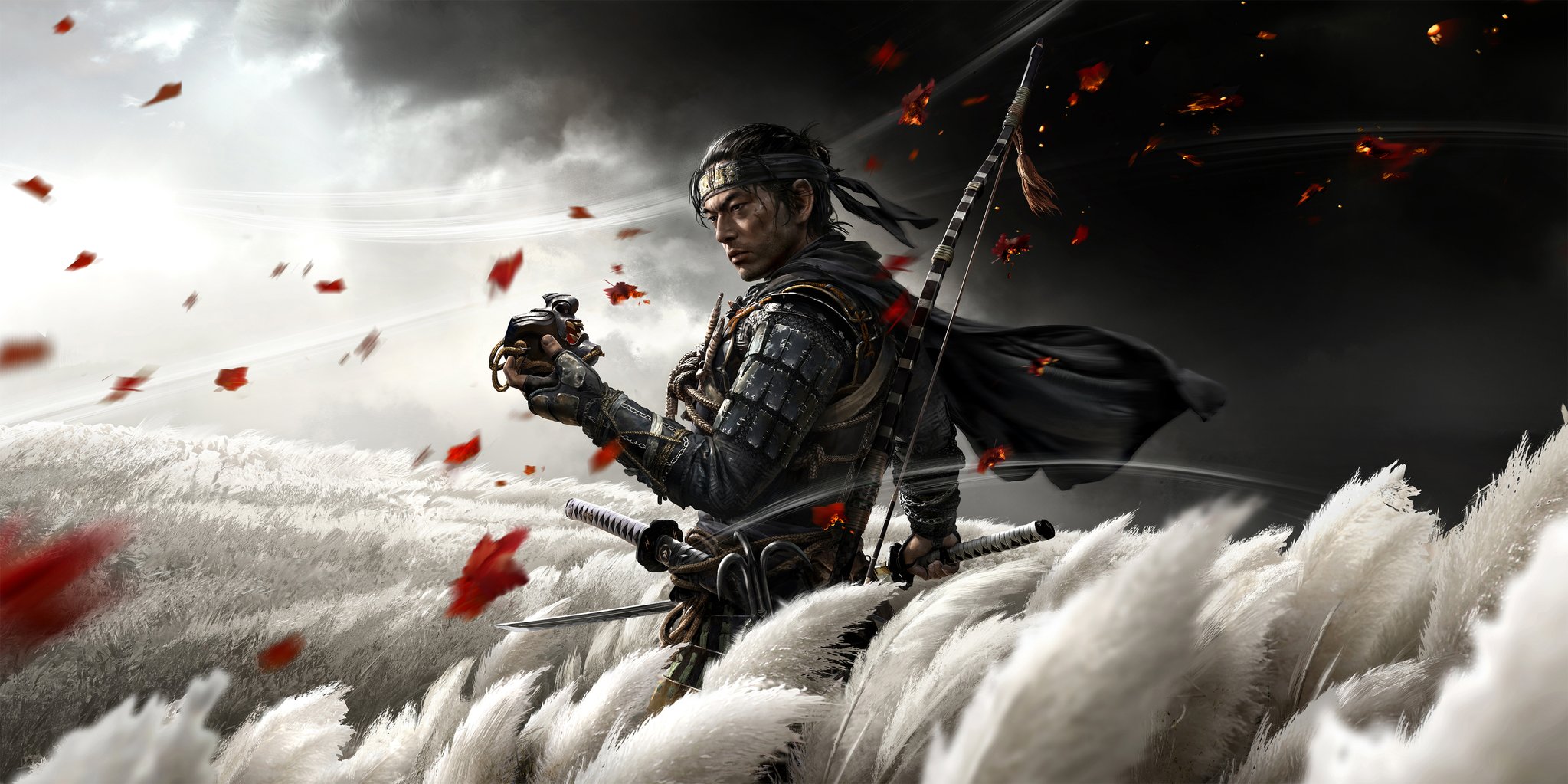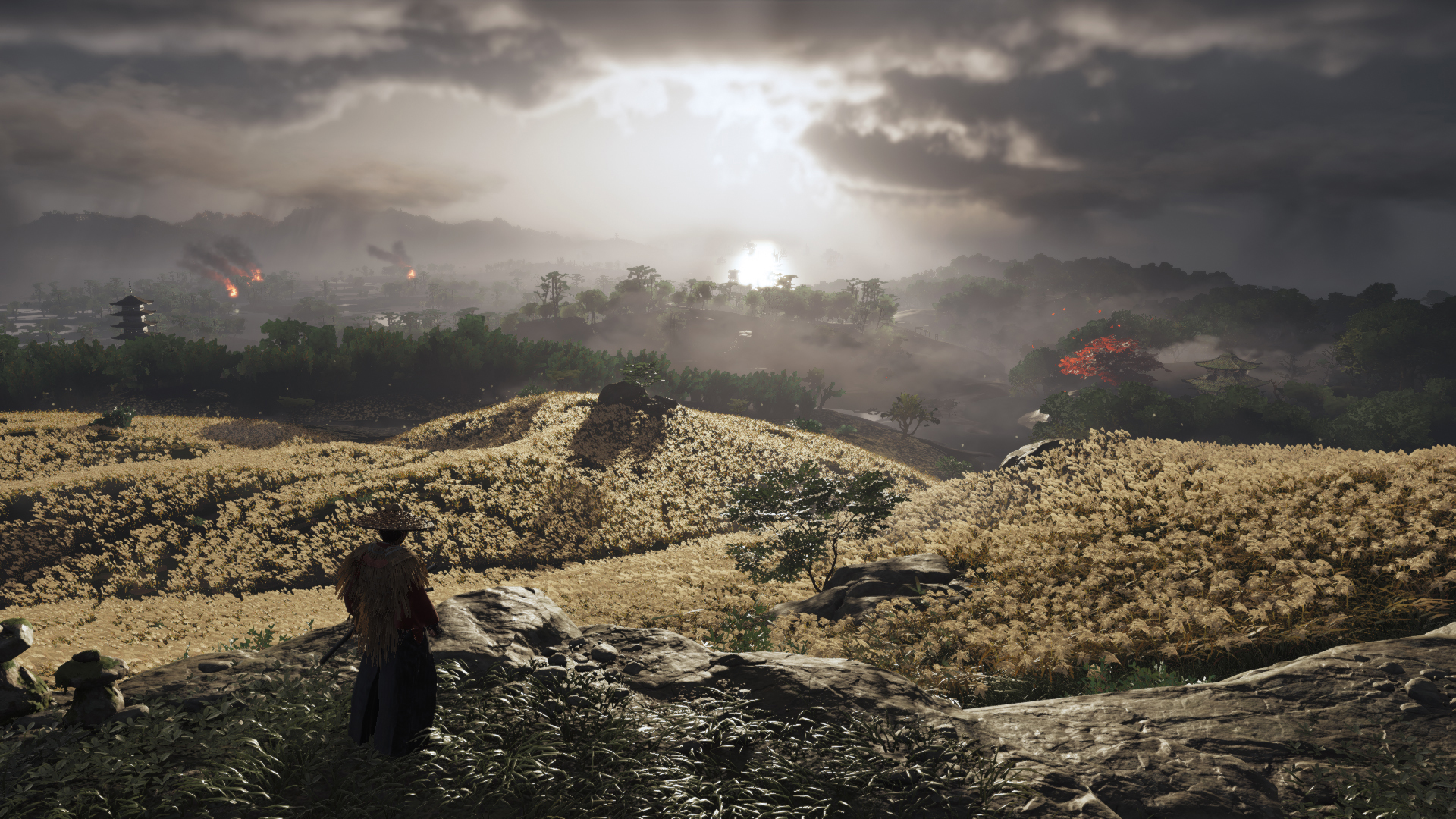Technical Data
Publisher/Developer: Sony Interactive Entertainment/ Sucker Punch Productions
Release Date: July 17, 2020
Played: Summer 2020

Ghost of Tsushima was released as the last big Sony exclusive game on PS4 before the launch of the PS5 at the end of 2020. It also falls strongly in the category of by the numbers open world games. Following every trend you can find in that genre quest design is not its strong suite. But there is so much more to it. One could accuse Ghost of being style over substance. But it manages to combine excellent visuals with exceptional gameplay. The story of Jin Sakai it tells - while not absolutely historically accurate - is also well paced and written. Sucking you into the events of the Mongle invasion of the Japanese island of Tsushima.
Where is the next flower field - quest design and repetitiveness of the open world
Ghost of Tsushima checks off all the tropes of open world games. In the runup to its launch it was often described as “Assassin's Creed in Japan”. And while I would disagree in large parts (story and gameplay are quite different) it is true, that Ghost resembles many of Ubisoft's games. There are a lot of collectable and enemy encampments to find. Quests mostly involve you getting somewhere to then kill bandits or mongoles. Sometimes you have to follow tracks to do so. And while I really like the idea that you don’t have some kind of special vision to light the foot prints up like a christmas tree, they can be hard to miss. Mostly they follow exactly the path you think they would, but that can in some cases just help a bit. (There actually is a Focus Hearing ability to detect enemies.) There are also some tailing missions - as expected and mandated by the overlords of the universe. Yes, they are annoying but at least there are not loades and they are better than some I had to endure in for example Black Flag. The quest design overall is a let down. Especially the side quests are mostly of the kind described above. The Mythical Tales always dive deep into lore and Japanese folklore always ending on a high note. Sadly they are let down by the first part of them: running through the open world to find a specific location. Yes, these are always focused on the beautiful landscape. Find a specific mountain or kind of flowers. Combined with the minimap less hub and the orientation managed over a gust of wind to call upon. The problem is, that it comes down to being a fetch quest. Other Quests - or tales - are better. The companion quests bring in a better story. Engaging with the personal stories of the remaining samurai is really worth it. And even though the underlying quests are not at all innovative, they shine through a lot. Obviously the main quests are grander. Giving you new abilities, tying into the main narrative and boss fights.
In between there is a lot to do in Ghost of Tsushima. A plethora of side activities involve finding little Inari shrines - fox dens, bambu strikes, hot springs, haiku spots and shinto shrines. Follow the foxes to get new charm spots. Charms - giving different buffs to Jin - can be found through side quests or on the shinto shrines. These are a work of beauty. The landscape around them is breathtaking. Entering them is a mixed experience. Players will need to climb them, which can feel empowering, especially with the before mentioned landscape. But you need to follow a given, a restricted path from which you may never differ. Otherwise defeat and death awaits. If you ask me (and you kind of are) it is well worth seeking out the shrines even if it can be aggravating completing them - they give the best charmes and look nice. The other collectables are quite simple: bambus strikes see Jin training to cut through bamboo with you hitting the right buttons in the right time, earning resolve which can be spent in fights to use abilities. Hot springs give Jin more life and Haiku spots let you actually write haikus - kind of. You more or less compose them from some predetermined set of sentences. You get new headbands for that. Overall the world of Tsushima is packed full but it never feels stuffed. There is just enough to do to keep you engaged but not too much.
Tsushimas Next Top Samurai - customization and progress
There are a lot of options to dress Jin in, that you can find in the world .Together with sword kits, there are the different armors you can get by progressing in the main quest or the mystical tales. They are kind of the ones that matter most. Giving Jin Sakai different ability buffs and focusing on a specific kind of combat or in one case exploration. It is best to change these as often as possible to get the best buffs for the situation you are in. Headgear is separated from all that and sees the most variants. But all of these options are a sight to behold and diverse. Gear can just like you sword, bow and other weapons be upgraded with the different resources you find around the world. Most of them can be found just by playing the game. There is not too much grind involved if you just pick up everything lying around. But at some point in the late game, it can become one with more materials being needed. Still it is not unplayable and clearly a cut above other games that mostly want you to buy time savers.
Jin's personal progress is bound as much to the RPG elements with skills to buy with experience points as well as story important missions. Jin has three different areas he can progress in. There are stances which need to be changed to tackle different enemies. After unlocking them they can be upgraded. The rest of the progression is split into ghost and samurai abilities. Overall progress feels variety and empowering. Jin will get as much better as the player will. Also most of the different combos and abilities, weapons that can be unlocked never are too much. They don’t feel a burden and it is fairly easy to remember and use them. Even at the end of the game, I felt I had a good grip on a complex system of abilities.
Ghost or samurai? - Gameplay and main story
While the sidequests in Ghost are not its strongest point, gameplay and main story are very much. Stances and ghost weapons give the player the ability for a varied approach to situations. Most games that involve stealth give you the option, but also a very strong incentive to actually use it. Maybe with more experience points or an easier playthrough. Ghost of Tsushima does not. Yes, in some situations it is easier to go in stealthy against for example a large group of enemies. But you can also just attack the encampment. The inclusion of the Standoff abilities allows players to get quickly and easily through a first wave of enemies or the little patrols out in the wild. While many of the Ghost abilities are nothing new, they also are not implemented badly. Yes, they can not hold up against the varied and multifaceted sword combat. But together they give the player a large enough and fun enough combat system. But there is not only this empowering battle between the player and a lot of Mongols. No, Ghost of Tsushima also has a dueling system. And while it is essentially just the same system but with tougher enemies. The changes to it make these feel much different. They are way harder, they make you feel like you are really battling against this one foe. Like you stand eye to eye with him and that you kill him is as certain as that you yourself die. They take a bit to get used to them, but they give boss fights and important story moments the impact they should have.
While the traversal in climbing and riding is quite basic, exploration is implemented in an interesting way. On his journey Jin uncovers the map by lifting the fog and finds that interesting locations are marked with a question mark to later seek out. Clearing an encampment lifts the fog in an area. But the big point is that Ghost has no minimap. Instead the player can swipe up on the trackpad to let a gust of wind indicate the way to the next objective. While out in the wild golden birds will escort the player with their friendly chirr to the nearest objective or little side activity. Yes, both of these systems are not flawless. Birds will guide you into unclimbable mountain sides or down a cliff. The wind only blows in a straight line to the next objective. But these systems make Ghost stand out amidst all the other open world games.
The different playstyles in Ghost of Tsushima are less of a choice for the player than the marketing makes it out. Yes, you do decide how to approach a given situation. But it is much more the set up for the story. Jin Sakai is one of the only survivors of the battle at Komoda Beach against the invading Mongle forces. With the whole island of Tsushima being occupied by them he has to make choices how to manage against this superiority and how to free his uncle Lord Shimura. The relationship of Jin to his Uncle is a central point of the main storyline. With some flashbacks to explore their history together, it is the struggle of how far Jin will go to free not only Lord Shimura but also all of Tsushima. The story has as many personal moments as it has epic and it is one of the main selling points of the whole game.
A sight to behold - visuals and art directions

The other point then are the visuals of Ghost of Tsushima. Games at the end of the lifespan of a console are often far away visually from the games at the beginning. The devs had time to really learn the ins and outs of the consoles they develop for. Ghost of Tsushima is a prime example for that. It is not only the landscape that is beautiful to look at. Particle effects as much as the dynamic weather are as well. The cinematic approach Sucker Punch had for the game can be seen through the whole game. The mentioned lack of a mini map is as much a sign for that as is the Kurosawa Mode. In this mode the game is in black and white like the films of the famous Japanese film maker. It may not be very practical to play in it us everything is harder to make out, but it speaks of the love and care the devs put into the game as there love for the Japanese culture itself. There are so much more beautiful aspects to Ghost of Tsushima. From the haikus to the foxes you can pet to the fact that every quest is introduced by a little title screen. And that makes it even stranger, that the animation for the characters faces is always the English one even if the dialogs are set to Japanese. In most parts of the game that makes not much of a difference but in cutscenes some people may notice it anyways.
Conclusion
Ghost of Tsushima is one of the most beautiful games on Playstation 4 to this day. It manages to marry it’s artstyle and cinematic visuals with a story that is impactful and interesting until the end. The combat system is varied and just fun. The only let down then is the design of the quests and some not perfectly implemented system, with an open world that in many parts plays it pretty safe. 8/10 Good
Disclaimer: Although this review is written after the release of the free co-op expansion, our reviewer was sadly not able to test this part of the game due to lack of a Playstation Plus membership.
 Essaytopia
Essaytopia